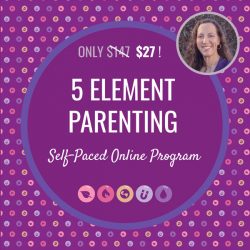First, go back and figure out YOUR 5-element type. If you haven’t already, read my earlier blog post titled “5 Steps to Figuring out YOUR 5-Element Type, Mommy and Daddy!”.
As I mentioned in the post about figuring out YOUR type, keep in mind that balance is key — all 5 types have their positives, challenges, and possible imbalances. Don’t wish your child were a different type…just accept his/her type and work WITH it — not against it. Any child can be successful with the right guidance, acceptance, and gift of self-awareness that comes with knowing his/her 5-element type.
The 5 elements are wood, fire, earth, metal, and water. Here are 5 steps to figuring out your child’s type.
#1 — The first step to narrow down your child’s type is to determine if your child is an introvert or extravert, or an even mix. If he/she tends to be outgoing and thrives at parties and other situations that involve lots of talking, then he/she is mainly an extravert, and is either wood or fire. If he/she prefers time alone, and retreats to his/her room alone when under duress, then he/she is likely an introvert, and is either metal or water. If he/she is in the middle somewhere, he/she may be earth.
#2 — Wood vs. Fire: If your child is extraverted, he/she is probably either wood or fire. How do you distinguish one from the other?
Wood kids tend to be fast-moving, intense, confident, and insist on doing things their way. They sometimes ignore authority figures, and they are sometimes early walkers and early talkers. Sometimes they cannot sit still during story time because they want to go on and do the next activity. Fire kids tend to be more enthusiastic, sensitive, emotional, dramatic, charismatic, and are often the “class clowns” in school. Fire kids also don’t like to be still — but in a more sensual way — as they get curious and try to pick up and touch everything when they go somewhere new.
“Any child can be successful with the right guidance, acceptance, and gift of self-awareness that comes with knowing his/her 5-element type.”
#3 — Metal vs. Water: If your child is introverted, he/she is probably either metal or water. Here is how to distinguish between the two.
Metal kids want to see justice done in all situations, and enjoy patterns and puzzles. They have trouble just doing “kid things” and having fun. Water kids tend to be slow-moving, cautious, and have no sense of time or urgency. They also tend to daydream. Sometimes these kids are wise beyond their years once they get older, but as young children they may be late walkers and late talkers, and may be less mature than their peers for a few years.
#4 — Earth: If your child is a mixture of introvert and extravert, he/she is likely an earth type.
Earth kids are nurturing, supportive, and try to make sure all the kids are happy. They are the kids that see a child in the corner alone at a party and invite him to join in on the fun. They naturally enjoy taking care of younger children. Sometimes in school, they learn better through relationships than by trying to memorize facts.
#5 — The Final Round
Are you confused? Do you feel your child is a mixture of more than one type? Try this — think of what motivates your child.

Does he/she love winning and planning, and ignore parents and teachers in favor of following his/her own agenda? This is a WOOD child.
Does he/she love being the star of the show, the life of the party, or is he/she the class clown in school? This is a FIRE child.
Does he/she sincerely love taking care of people and obsess over seeing everyone happy? This is an EARTH child.
Does he/she love when everything makes sense, falls into a predictable pattern, and justice is served? This is a METAL child.
Does he/she prefer to have daily quiet time, and take an hour to get ready for school in the morning? Do other parents seem jealous that your child is so “chill” and follows orders from teachers without trouble? This is a WATER child.
What is your child’s type? Please comment below, and ask any questions this may have brought up for you. For one-page reference guides for each type of child, please contact us.

